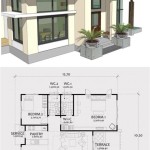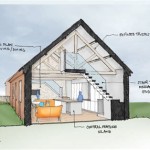How To Convert Floor Plan Measurements
Floor plans are essential blueprints for understanding the layout and dimensions of a building or space. They provide a scaled representation of rooms, walls, doors, windows, and other structural elements. These plans are crucial for architects, builders, interior designers, real estate professionals, and homeowners alike. A key skill in working with floor plans is the ability to convert measurements accurately between different units and scales. This article will provide a comprehensive guide on how to perform these conversions effectively.
Measurements on a floor plan are rarely represented in their actual size. They are typically scaled down to fit on a manageable piece of paper or a digital screen. The scale indicates the ratio between the dimensions on the plan and the corresponding dimensions in the real world. Common scales include 1/4 inch = 1 foot, 1/8 inch = 1 foot, and 1:50 or 1:100 in metric units. Understanding and correctly applying the scale is the foundation for all floor plan measurement conversions.
Understanding Common Floor Plan Units and Scales
The units used on a floor plan are typically based on the standard measurement system of the region where the building is located. In the United States, inches and feet are commonly used, while metric units, such as millimeters and meters, are standard in many other parts of the world. A thorough understanding of these units and their relationship to each other is essential for accurate conversions.
In the imperial system:
- 1 foot = 12 inches
- 1 yard = 3 feet
In the metric system:
- 1 meter = 100 centimeters
- 1 centimeter = 10 millimeters
- 1 kilometer = 1000 meters
It is also important to understand how these systems relate to each other. The most common conversion factors are:
- 1 inch = 2.54 centimeters
- 1 foot = 0.3048 meters
- 1 meter = 3.28084 feet
Scales on floor plans are typically expressed as a ratio or an equivalence. A ratio scale, such as 1:50, means that 1 unit on the plan represents 50 units in reality. An equivalence scale, such as 1/4 inch = 1 foot, means that 1/4 inch on the plan represents 1 foot in the actual building. It is vital to carefully identify the scale of the floor plan before attempting any measurement conversions. A misidentified scale will lead to inaccurate results.
To effectively interpret a scale, one needs to understand its implications. For example, if a floor plan has a scale of 1/4 inch = 1 foot, then every quarter inch measured on the plan corresponds to one actual foot in the building. This allows one to determine the real-world dimensions of elements by measuring their representation on the plan and applying the scale factor.
Converting Measurements from Plan to Actual Size
The process of converting measurements from a floor plan to the actual size involves several steps. First, it is necessary to accurately measure the dimension on the floor plan using a ruler or a digital measurement tool. Second, one must identify the scale of the floor plan. Finally, the measured dimension is multiplied by the scale factor to obtain the real-world dimension.
Here is a step-by-step guide to converting measurements:
- Measure the dimension on the floor plan: Use a ruler or a digital measurement tool to accurately measure the length, width, or other relevant dimension on the floor plan. Ensure the measurement is taken in the units specified on the plan, such as inches or millimeters.
- Identify the scale of the floor plan: Locate the scale indicator on the floor plan. It is usually found in the title block or near the plan's margins. Note the scale in the correct format, for example, 1/4 inch = 1 foot or 1:50.
- Determine the scale factor: If the scale is given as an equivalence (e.g., 1/4 inch = 1 foot), the scale factor is the number of real-world units represented by one unit on the plan. In this case, 1/4 inch represents 12 inches (1 foot), so the scale factor is 12 / (1/4) = 48. If the scale is given as a ratio (e.g., 1:50), the scale factor is simply the number on the right side of the ratio, which is 50.
- Multiply the measured dimension by the scale factor: Multiply the measurement taken from the floor plan by the scale factor to obtain the actual dimension. For example, if the measured dimension on the plan is 2 inches and the scale factor is 48 (from 1/4 inch = 1 foot), the actual dimension is 2 inches * 48 = 96 inches, or 8 feet.
For metric units, the process is similar. If the scale is 1:100 and the measurement on the plan is 5 centimeters, the actual dimension is 5 cm * 100 = 500 cm, or 5 meters.
It is crucial to pay attention to the units of measurement. Ensure that the units are consistent throughout the conversion process. If the measured dimension is in inches and the scale is in feet, convert the units to be compatible before performing the multiplication.
Converting Between Different Units of Measurement
Sometimes, it is necessary to convert measurements between different units, such as converting inches to feet, feet to meters, or centimeters to inches. This is a common task when working with floor plans that use different measurement systems or when comparing dimensions across different sources.
Here are some common unit conversions:
- Inches to feet: Divide the number of inches by 12. For example, 48 inches = 48 / 12 = 4 feet.
- Feet to inches: Multiply the number of feet by 12. For example, 5 feet = 5 * 12 = 60 inches.
- Feet to meters: Multiply the number of feet by 0.3048. For example, 10 feet = 10 * 0.3048 = 3.048 meters.
- Meters to feet: Multiply the number of meters by 3.28084. For example, 2 meters = 2 * 3.28084 = 6.56168 feet.
- Centimeters to inches: Divide the number of centimeters by 2.54. For example, 25.4 centimeters = 25.4 / 2.54 = 10 inches.
- Inches to centimeters: Multiply the number of inches by 2.54. For example, 6 inches = 6 * 2.54 = 15.24 centimeters.
When performing unit conversions, it is helpful to use a conversion table or an online conversion tool to ensure accuracy. Double-check the conversion factors and the units to avoid errors. It's especially important to know the desired level of precision. Most practical applications don't need more than two decimal places for the final conversion.
Consider an example where one needs to determine the length of a wall in meters, given that the floor plan uses a scale of 1/4 inch = 1 foot and the wall measures 3 inches on the plan. First, determine the actual length in feet: 3 inches * (4 feet/inch) = 12 feet. Then, convert the length from feet to meters: 12 feet * 0.3048 meters/foot = 3.6576 meters. Therefore, the actual length of the wall is approximately 3.66 meters.
Another example involves a conversion from metric to imperial. Suppose a floor plan uses a scale of 1:50 and a door measures 2 centimeters on the plan. The actual width of the door in centimeters is 2cm * 50 = 100 cm, or 1 meter. To convert this to inches, multiply by 39.37 (inches per meter), which gives 39.37 inches. Dividing by 12 gives approximately 3.28 feet.
These conversion steps are valuable when comparing floor plans from different regions or when ordering materials that are specified in a different unit system.
Accurate measurement is the cornerstone of successful floor plan interpretation. This includes careful use of measuring tools, a clear understanding of plan notations, and the diligent application of scale and units conversions. Professionals and homeowners alike can leverage this knowledge to optimize their projects and ensure accurate representation of space.

Convert Image To Floor Plan How Turn An Into A

Convert Scale Measurements Into Real Life House Plan With Grid

How To Draw A Floor Plan Scale Measuring Sketching

Scale For Floor Plans

How To Draw A Floor Plan Scale Measuring Sketching

Year 6 Convert Scale Measurements Into Real Life Measurement

How To Draw A Floor Plan Scale Measuring Sketching

How To Draw A Floor Plan Scale Measuring Sketching

How To Automatically Convert Sketchup Model Into 2d Floorplan With Measurement Requests Discussion Community

How To Read Floor Plans With Dimensions A Guide
Related Posts








